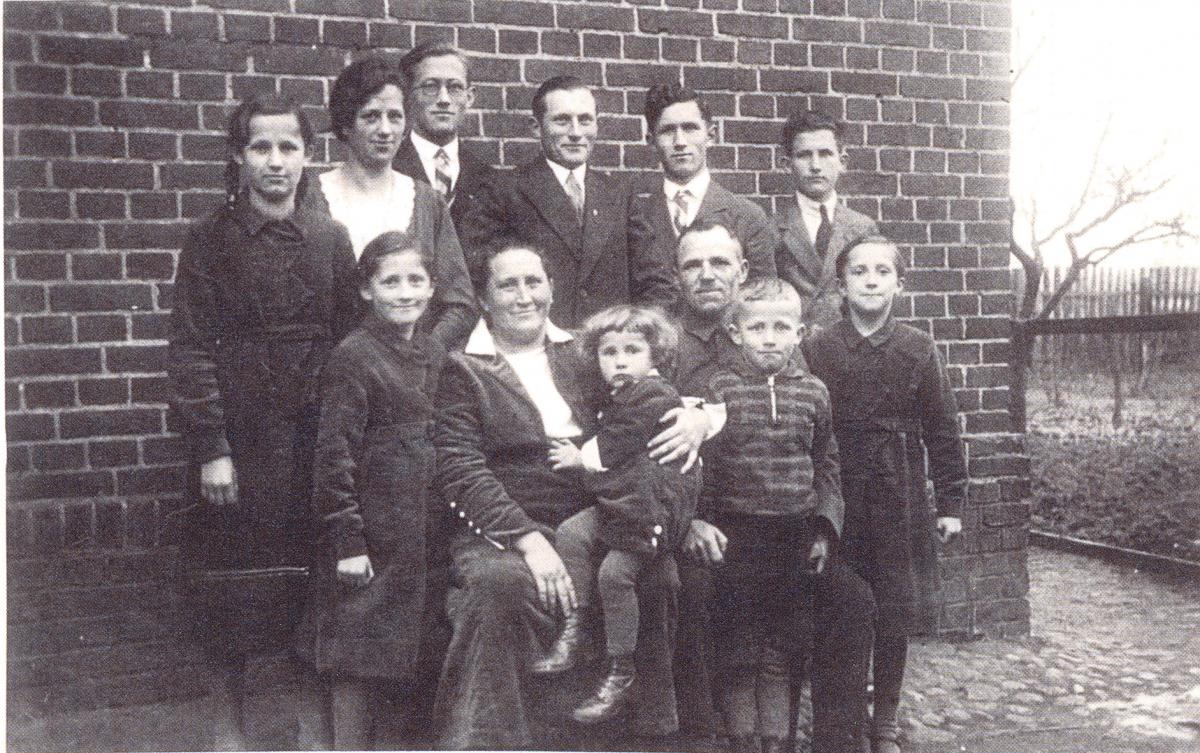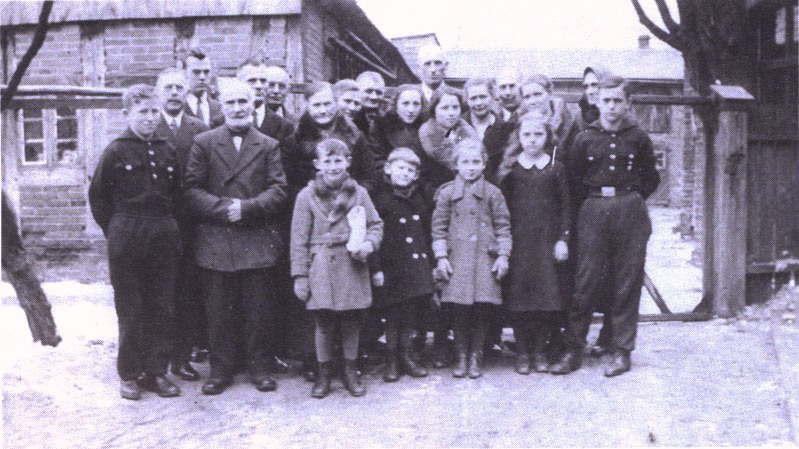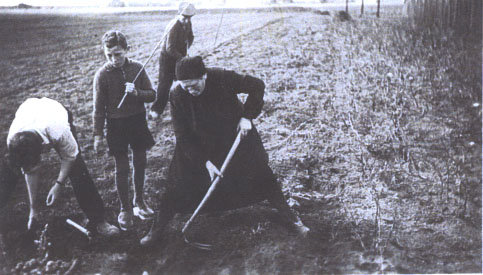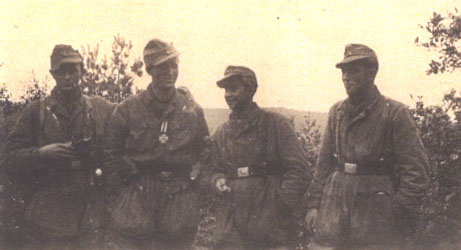Kreuz Branch, Schneidemühl District
Roger P. Minert, In Harm’s Way: East German Latter-day Saints in World War II (Provo, UT: Religious Studies Center, Brigham Young University, 2009), 387-92.
Often referred to as “Kreuz an der Ostbahn,” the town of Kreuz in Pomerania was located on the north bank of the Netze River (the border of Germany and Poland) between the world wars. The Ostbahn was the main railway line running from Berlin east through Schneidemühl and the so-called Polish Corridor to the Free City of Danzig.
| Kreuz Branch[1] | 1938 |
| Elders | 2 |
| Priests | 0 |
| Teachers | 2 |
| Deacons | 2 |
| Other Adult Males | 4 |
| Adult Females | 19 |
| Male Children | 3 |
| Female Children | 0 |
| Total | 32 |
The Kreuz Branch had only thirty-two members at the end of 1938; the population would have been about the same when war began on September 1, 1939. The branch president at the time was Arnold Schmidt, who served in that calling throughout the war.
The history of the East German Mission contains this entry for Monday, Nov 21, 1938:
From this day until December 15th, all meetings were forbidden in the Schönlanke and Kreuz Branches, Schneidemühl District. This measure was taken on account of a hand and mouth epidemic which prevailed in this section of Germany.[2]
The largest family in the Kreuz Branch was that of Gustav and Emilie Mudrow. With ten children, the family constituted fully one-third of the branch. Sister Mudrow was awarded the Mutterkreuz (Mother’s Cross) of the Nazi Party for having so many children.[3]
Son Helmut Mudrow (born 1925) described in detail the rooms rented by the branch at Hindenburgstrasse 2:
It was a former apartment. There were two rooms in the apartment where a wall was taken out, and the big room was used for sacrament meetings and other meetings. And we had four classrooms. We had a primary class, a kindergarten class, and an art class. The art class was for teenagers. The kindergarten class was for children until about six. And then the primary class was from six until twelve. Those over twelve were in the youth class. There was only one main floor. We had a little show window on the street with a sign. The sign was about two by one foot with the name Kirche Jesu Christi der Heiligen der Letzten Tage.[4]
On Sunday mornings, priesthood meeting took place at 9:00 a.m. and was followed by a prayer meeting and Sunday School. Sacrament meeting was held in the evening.
 The Mudrow Family in 1931. Eight of the ten children had war-related occupations or assignments. The entire family survived the war. (H. Mudrow)
The Mudrow Family in 1931. Eight of the ten children had war-related occupations or assignments. The entire family survived the war. (H. Mudrow)
To Helmut Mudrow, being a Latter-day Saint had its advantages:
When we had the religion classes [in school], the woman [who] was teaching it knew that I knew more about the Bible than any of the other students, because I went to church and we learned that. I didn’t have any problems whatsoever. Everybody knew that I was a Mormon.
At age ten, Helmut was inducted into the Jungvolk with his classmates and at age fourteen made the transition to the Hitler Youth in 1939—the year World War II started. The activities took place on Wednesdays and Saturdays and did not interfere with church attendance. Helmut was large for his age and became a Hitler Youth leader. Some of the activities included schooling in political subjects.
 Members of the Kreuz Branch in 1938 (H. Mudrow)
Members of the Kreuz Branch in 1938 (H. Mudrow)
Because they were living right on the German-Polish border, the members of the Kreuz Branch were aware of some of the conflicts that preceded the outbreak of the war. They knew of troubles between Polish citizens and ethnic Germans just across the river in Poland. There was apparently a very intense anti-German atmosphere in Poland.[5]
Helmut also recalled an incident that occurred in 1937 involving American missionaries: “Starting in 1935, the Germans were building some fortifications, some bunkers, and some fox holes along the border, about a half mile away from the border on a little hill there.” A missionary named Walton disregarded the sign that read, “Sicherheitszone: Photographieren verboten!” (“Secure Area: Photography forbidden!”) and took pictures. When Elder Walton’s pictures were developed in the local drugstore, the owner reported him to the Gestapo and he was arrested. While he was interrogated in Schneidemühl for three days, his companion, George Larkin, stayed in the apartment in Kreuz. Elder Walton was released without harm, but the missionaries were required to leave Kreuz.
In the week before the invasion of Poland, large numbers of German troops moved into and around Kreuz in anticipation of the attack. By September 21, 1939, the Polish campaign was over and the Wehrmacht was victorious. For several years after the campaign, Kreuz was far from any action connected with the war.
Branch resident Arnoldt Schmidt had married Gertrud Blechschmidt of the Meerane Branch (Zwickau District) in 1934. She became a devoted member of the Kreuz Branch and had served as the Relief Society president of the Schneidemühl District. In 1941, she was a Red Cross nurse and became seriously ill. As she later wrote,
I really fought for my very life. One time I clearly remember kneeling in my bed and praying to my Heavenly Father to spare my life, because I wanted to be with the Saints during the gathering of Israel. I received the blessings of the priesthood, and I began to improve. For the doctor it was a great miracle since he thought that I would never live through an illness of this nature.[6]
 Kreuz Branch members digging for potatoes in 1940 (H. Mudrow)
Kreuz Branch members digging for potatoes in 1940 (H. Mudrow)
In April 1942, Helmut Mudrow was completing his apprenticeship with the national railroad system. As a large young man, he was often asked why he had not yet joined the army. Finally, he decided to do so and got his father’s permission. As a volunteer, he had a choice of assignments and requested flight training. The recruitment officer responded, “Everyone wants to be a pilot. What about the paratroops?” “That’s fine! Sign me up!” Half of the volunteers were rejected, but Helmut was accepted. His jump training took place near Berlin, where representatives of the Axis nations watched with interest.
Helmut’s first jump was done from 3,300 feet. He later recalled the experience:
That was really enjoyable except getting out, jumping out of the airplane there. But then once we get out there, hanging there, and you can see all the landscape there and coming down. The sun was shining. I remember coming down and just went to my knees. . . . Hooked it on, and nothing happened at the end.
The paratroops were some of Hitler’s favorites, and were thus constantly being observed, paraded, and filmed. Nevertheless, life for those who jumped from planes was not always romantic. For example, during one training jump (Helmut made nineteen jumps in all), the wind kicked up when he landed and his parachute dragged him a half-mile across the ground before he could get to his feet.
Helmut’s tour of duty took him to Africa, Italy, and Malta. When the German army retreated at El Alamein, Egypt, Helmut and thirty comrades wandered in the desert for ten days. At one point, they drank water from the radiators of abandoned vehicles in order to stay alive. By the time they were rescued, only five of them had survived.
In the desert climate, Helmut became seriously ill and lost one-third of his weight. This earned him sick leave, and he was sent to southern Germany to recuperate. In 1943, he went home on furlough. By then, most of his siblings were in the service of the Reich and were away from home. While at home, he was ordained a priest by branch president Arnold Schmidt with the approval of district president Johannes Kindt.
Back in action, Helmut was in Italy while the Americans were advancing northward up the peninsula toward Rome. Without jumping from an airplane, he fought at Monte Casino and Anzio. He was wounded by shrapnel five times, but never critically. In 1944, he was sent to France and stationed where German military leaders expected the Allied invasion to take place. When their calculations proved wrong, the paratroops were moved to Caen on the Normandy coast. However, it was too late for Helmut and his comrades to stop the American advance into France, and they were moved away from the combat zone again.
Helmut Mudrow may have seen action at more locations of the war than any other LDS soldier. From the Normandy region, he was moved north and fought the Allied invaders in the Netherlands as part of the Allied-Market-Garden operation of September 1944. He also participated in the Battle of the Bulge in December 1944 and January 1945.
 Paratrooper Helmut Mudrow (second from left) receives another medal in 1944. (H. Mudrow)
Paratrooper Helmut Mudrow (second from left) receives another medal in 1944. (H. Mudrow)
Helmut’s parents fled Kreuz on January 26, 1945, as the Soviet invaders approached. It is very likely that the remainder of the Saints in Kreuz left at the same time. Over the next three years, the Mudrow family members established contact with each other through various communications media. All twelve of them survived the war.
Gertrud and Arnold Schmidt also departed Kreuz in January 1945 as the Saints continued to abandon that city. The last branch activity was a large party held in the Schmidt home. Gertrud’s account reads thus:
In honor of our 10th wedding anniversary we invited the entire branch membership and announced it as our “Adventsfeier” which means the “advent of Christmas.” At the time nobody was thinking that this might be our last home gathering.[7]
The Schmidts then prepared to join the exodus from Kreuz. Gertrud later wrote,
The rolling thunder of the battle front in the east was coming closer to our small town. . . . We visited the members of the branch for one last time to see if any help was needed. Many of the families had already left their homes. Early in the morning of that day, Arnold had said to me, “Gertrud, an inner voice tells me we should go now.” . . . We loaded a small hand cart with some suitcases filled with clothing and church records of the Schneidemühl District, and before we left our so dearly beloved home we kneeled in prayer and thanked the Lord for so many blessings and for the comfortable home we had had, and asked Him for His protection and guidance.[8]
No trains were available to take the Schmidts west. Arnold Schmidt had a weak heart, and the journey on foot was very difficult for him. Fortunately, a ride on a wagon was possible at times. They arrived in Landsberg on the Warthe River that Saturday and were taken in by the branch Relief Society president. The next day, they attended a testimony meeting there. Gertrud Schmidt recalled, “The meeting was so inspiring and heart-warming, there among friends during such a difficult time; many tears were shed by all.” The next morning, the word went out that the Soviets were very close to Landsberg. When the Schmidts left the city in the opposite direction, they took nothing along but the church records.[9]
The Schmidts were in a hurry to get to the home of Gertrud’s parents in Meerane, but they made a detour and delivered the church records to the mission leaders in Berlin. Then they headed south without further delay. By February 1, they reached their destination, having been on the road for eight days and covering about 275 miles.[10]
By April 1945, Helmut Mudrow’s unit had moved farther east into the Reich. One day he told his men that the war was essentially over and that they might want to consider discarding their uniforms in order to get home without being taken prisoner. He and several comrades then dressed as civilians and traveled through Germany, bypassing American army checkpoints as they went. They were stopped once but talked their way through and kept walking. Along the way, Helmut found work with a farmer and stayed on the farm for three years, waiting for the confusion of postwar Germany to subside.
In 1948, Helmut Mudrow left the farm to begin a new life. As a paratrooper, he had experienced the war on three different fronts, had earned the Iron Cross First Class, and was wounded five times. For a time, he had carried the Book of Mormon but never served with another Latter-day Saint soldier and never attended church except when on leave in Kreuz.
By 1946 at the latest, there were no Latter-day Saints left in Kreuz, and the branch ceased to exist. The name of the town was soon changed to Krzyż Wielkopolski, Poland.
In Memoriam:
The following member of the Kreuz Branch did not survive World War II:
Kurt Herbert Erwin Vielstich b. Kreuz, Pommern, Preussen 1 Oct 1915; son of Karl Friedrich Vielstich and Frieda Margarete Hildegard Quolke; bp. 5 Apr 1927; lance corporal; d. Braye, Chemin-des-Dames, France 5 Jun 1940; bur. Fort-de-Malmaison, France (H. Mudrow; www.volksbund.de; IGI; PRF)
Notes
[1] Presiding Bishopric, “Financial, Statistical, and Historical Reports of Wards, Stakes, and Missions, 1884–1955,” CR 4 12, 257.
[2] East German Mission Quarterly Reports, 1938, no. 47, East German Mission History.
[3] The Mutterkreuz was awarded in three degrees: for five, seven, and nine or more children.
[4] Helmut Mudrow, interview by the author, Ogden, Utah, May 25, 2006.
[5] See the story told by Rudi Seehagen in the chapter on the Spandau Branch, Berlin District.
[6] Gertrud Schmidt, autobiography (unpublished), 14.
[7] Ibid., 14.
[8] Ibid., 14–15.
[9] Ibid., 16.
[10] Ibid., 16.
